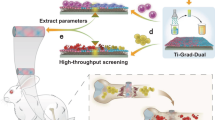Abstract
Surface modification of acid-pretreated titanium with 3-aminopropyltriethoxylsilane (APTES) in dry toluene resulted in covalently bonded siloxane films with surface coverage that was relatively controllable by regulating the reaction conditions. A hetero-bifunctional cross-linker, N-succinimidyl-3-maleimidopropionate (SMP), reacted with the terminal amino groups, forming the exposed maleimide groups. Finally, a model cell-binding peptide, Arg–Gly–Asp–Cys (RGDC), was immobilized on the surface through covalent addition of the cysteine thiol groups to the maleimide groups. X-ray photoelectron spectroscopy, radiolabelling techniques, and ellipsometry were used to quantify and characterize the modified surfaces.
Similar content being viewed by others
References
S. A. BROWN and J. E. LEMONS, in “Medical Applications of Titanium and its Alloys: The Material and Biological Issues” (American Society for Testing and Materials, Philadelphia, PA, 1996).
P. J. DOHERTY, R. L. WILLIAMS, D. F. WILLIAMS, in “Biomaterial-Tissue Interfaces” (Elsevier, Amsterdam, 1992).
S. P. MASSIA and J. A. HUBBELL, Anal. Biochem. 187 (1990) 292.
R. F. VALENTINI, D. FERRIS, et al. in “Proceedings of the 23rd Annual Meeting of the Society for Biomaterials”, April 1997, New Orleans, USA, p. 55.
K. C. LEE, T. T. ANDERSEN and R. BIZIOS, ibid., p. 60.
J. P. BEARINGER, C. H. THOMAS and K. E. HEALY, ibid. p. 54.
A. REZANIA, C. H. THOMAS, A. B. BRANGER, C. M. WATERS and K. E. HEALY, J. Biomed. Mater. Res. 36 (1997) in press.
S. HEYSE, H. VOGEL, M. SANGER and H. SIGRIST, Protein Chem. 4 (1995) 2532.
R. KURRAT, M. TEXTOR, J. J. RAMSDEN, P. BÖNI and N. D. SPENCER, Rev. Sci. Instrum. 68 (1997) 2172.
S. EVANS, R. G. PRITCHARD and J. M. THOMAS, J. Electron Spectrosc. Rel. Phenom. 14 (1978) 341.
D. A. STENGER, J. H. GEORGER, C. S. DULCEY, et al., J. Amer. Chem. Soc. 114 (1992) 8435.
N. JENTOFT and D. G. DEARBORN, J. Biol. Chem. 254 (1979) 4359.
J. LAUSMAA, J. Electron Spectrosc. Rel. Phenom. 81 (1996) 343.
S. MISHRA and J. J. WEIMER, in “Procedings of the 23rd Annual Meeting of the Society of Biomaterials”, April 1997, New Orleans, USA, p. 123.
R. W. PAYNTER and B. D. RATNER, in “Surface and Interfacial Aspects of Biomedical Polymers, Protein Adsorption”, Vol. 2, edited by J. D. Andrade (Plenum, New York, 1985) p. 189.
Author information
Authors and Affiliations
Rights and permissions
About this article
Cite this article
XIAO, S.J., TEXTOR, M., SPENCER, N.D. et al. Immobilization of the cell-adhesive peptide Arg–Gly–Asp–Cys (RGDC) on titanium surfaces by covalent chemical attachment. Journal of Materials Science: Materials in Medicine 8, 867–872 (1997). https://doi.org/10.1023/A:1018501804943
Issue Date:
DOI: https://doi.org/10.1023/A:1018501804943




